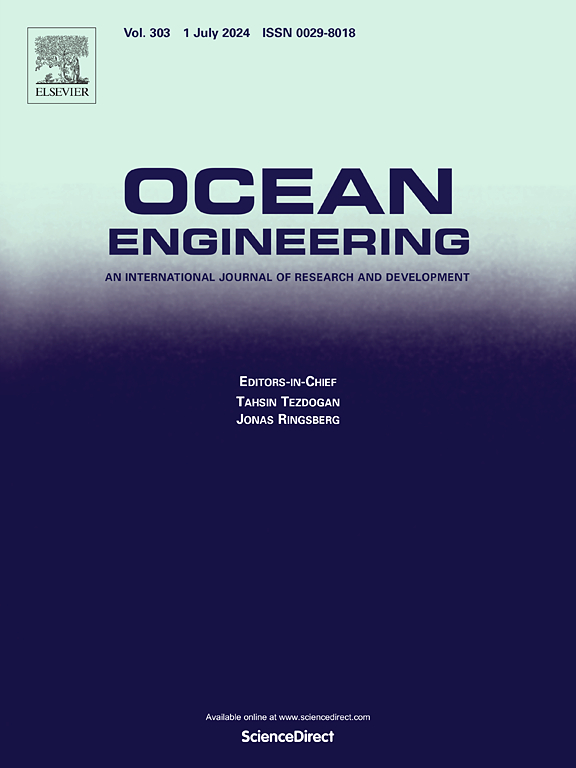考虑波浪作用下的起伏和俯仰运动的波浪动力船动力学
IF 5.5
2区 工程技术
Q1 ENGINEERING, CIVIL
引用次数: 0
摘要
波浪动力船利用波浪引起的起伏和俯仰运动来产生向前推进力,从而具有无限的耐力。本文基于流体与多体耦合方法,研究了波浪动力船在波浪和俯仰耦合作用下的串联水翼推进性能和能量利用性能。对串联水翼的耦合运动进行了数学描述,研究了在纯升沉、纯俯仰以及升沉和俯仰耦合激励下,前后水翼的推进效果、压力分布和涡相互作用。研究表明,升沉运动和俯仰运动之间的相互作用对提高串列水翼的推进性能至关重要,俯仰运动是提高串列水翼能量转换效率的关键因素。耦合激励下的俯仰幅值会影响串列水翼运动之间的相位差,导致串列水翼上下行程的推力和阻力分布不对称,从而有可能影响串列水翼的稳定性。提高俯仰幅值可以减小前水翼尾迹对后水翼的干扰,显著提高串联水翼的推进性能和能效。该研究可为波浪动力船推进性能的设计与优化提供参考。本文章由计算机程序翻译,如有差异,请以英文原文为准。
Dynamics of wave powered boat considering the heave and pitch motion excited by waves
Wave-powered boats generate forward propulsion by utilizing the heave and pitch motions induced by waves, allowing for potentially unlimited endurance. In this paper, the propulsion and energy utilization performance of tandem hydrofoils mounted on a wave-powered boat considering the coupled heave and pitch excitation is investigated based on a fluid and multibody coupling method. The coupled motion of the tandem hydrofoils is mathematically described, and the propulsion effects of the front and rear hydrofoils, as well as the pressure distribution and the vortex interaction, are examined under the pure heave, pure pitch and coupled heave and pitch excitations. The research indicates that the interplay between heave and pitch motion is critical for maximizing the tandem hydrofoil's propulsion performance, and the pitch motion is the key component responsible for enhancing the energy conversion efficiency of the hydrofoils. The pitch amplitude in coupled excitation affects the phase difference between the movements of the tandem hydrofoils, resulting in an asymmetric thrust and resistance distribution during their upstroke and downstroke, which has the potential to affect the stability of the tandem hydrofoils. Furthermore, an increase in pitch amplitude can reduce the interference of the front hydrofoil's wake on the rear hydrofoil, significantly enhancing both the propulsion performance and energy efficiency of tandem hydrofoils. This study can provide a reference for the design and optimization of the propulsion performance of the wave-powered boats.
求助全文
通过发布文献求助,成功后即可免费获取论文全文。
去求助
来源期刊

Ocean Engineering
工程技术-工程:大洋
CiteScore
7.30
自引率
34.00%
发文量
2379
审稿时长
8.1 months
期刊介绍:
Ocean Engineering provides a medium for the publication of original research and development work in the field of ocean engineering. Ocean Engineering seeks papers in the following topics.
 求助内容:
求助内容: 应助结果提醒方式:
应助结果提醒方式:


